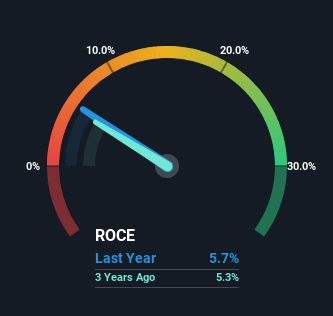- New Zealand
- /
- Electric Utilities
- /
- NZSE:CEN
Slowing Rates Of Return At Contact Energy (NZSE:CEN) Leave Little Room For Excitement

If you're not sure where to start when looking for the next multi-bagger, there are a few key trends you should keep an eye out for. Firstly, we'd want to identify a growing return on capital employed (ROCE) and then alongside that, an ever-increasing base of capital employed. This shows us that it's a compounding machine, able to continually reinvest its earnings back into the business and generate higher returns. However, after briefly looking over the numbers, we don't think Contact Energy (NZSE:CEN) has the makings of a multi-bagger going forward, but let's have a look at why that may be.
Understanding Return On Capital Employed (ROCE)
For those that aren't sure what ROCE is, it measures the amount of pre-tax profits a company can generate from the capital employed in its business. Analysts use this formula to calculate it for Contact Energy:
Return on Capital Employed = Earnings Before Interest and Tax (EBIT) ÷ (Total Assets - Current Liabilities)
0.057 = NZ$285m ÷ (NZ$5.8b - NZ$780m) (Based on the trailing twelve months to June 2023).
So, Contact Energy has an ROCE of 5.7%. On its own that's a low return on capital but it's in line with the industry's average returns of 5.7%.
See our latest analysis for Contact Energy

In the above chart we have measured Contact Energy's prior ROCE against its prior performance, but the future is arguably more important. If you'd like, you can check out the forecasts from the analysts covering Contact Energy here for free.
So How Is Contact Energy's ROCE Trending?
There hasn't been much to report for Contact Energy's returns and its level of capital employed because both metrics have been steady for the past five years. It's not uncommon to see this when looking at a mature and stable business that isn't re-investing its earnings because it has likely passed that phase of the business cycle. With that in mind, unless investment picks up again in the future, we wouldn't expect Contact Energy to be a multi-bagger going forward. That probably explains why Contact Energy has been paying out 113% of its earnings as dividends to shareholders. If the company is in fact lacking growth opportunities, that's one of the viable alternatives for the money.
The Key Takeaway
We can conclude that in regards to Contact Energy's returns on capital employed and the trends, there isn't much change to report on. Since the stock has gained an impressive 76% over the last five years, investors must think there's better things to come. However, unless these underlying trends turn more positive, we wouldn't get our hopes up too high.
If you want to know some of the risks facing Contact Energy we've found 2 warning signs (1 makes us a bit uncomfortable!) that you should be aware of before investing here.
While Contact Energy isn't earning the highest return, check out this free list of companies that are earning high returns on equity with solid balance sheets.
New: AI Stock Screener & Alerts
Our new AI Stock Screener scans the market every day to uncover opportunities.
• Dividend Powerhouses (3%+ Yield)
• Undervalued Small Caps with Insider Buying
• High growth Tech and AI Companies
Or build your own from over 50 metrics.
Have feedback on this article? Concerned about the content? Get in touch with us directly. Alternatively, email editorial-team (at) simplywallst.com.
This article by Simply Wall St is general in nature. We provide commentary based on historical data and analyst forecasts only using an unbiased methodology and our articles are not intended to be financial advice. It does not constitute a recommendation to buy or sell any stock, and does not take account of your objectives, or your financial situation. We aim to bring you long-term focused analysis driven by fundamental data. Note that our analysis may not factor in the latest price-sensitive company announcements or qualitative material. Simply Wall St has no position in any stocks mentioned.
About NZSE:CEN
Contact Energy
Generates and sells electricity and natural gas in New Zealand.
Fair value second-rate dividend payer.
Similar Companies
Market Insights
Community Narratives




